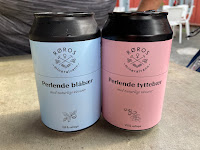Røros is built on copper mining. Mining started in this area about 350 years ago. The whole area is a UNESCO World Heritage Site. This includes an area with a 30 km circumference. I learned this trip that it is always a partnership with UNESCO. The government in the country where the site is has to agree to maintain it, and UNESCO provides support. Interesting.
 |
| Skottgården (Sue's photo) |
The farm was historically in her family for many, many generations, but relatives of hers decided to sell it some years ago. Oda bought it back, and turned it into a guest house. It had been one at some time previously, though I am not sure if it was a skysstatjon or not.
 |
| The breakfast spread. (Martha's photo) |
The food on the table was all locally sourced, amazing! You can see here fresh liver pate, meats raised and cured locally, cheeses from a special dairy, and homemade jams - rhubarb, rhubarb beet, and cloudberry! A room and breakfast at this fine establishment? About $80/night at the current exchange rate. A bargain!
This is also a house filled with music. Oda's relatives played fiddle, and this is where the Brekken Spelemannslag rehearses. They sit right in the dining hall where we had breakfast, and play their local tunes. This was a great place for us!
 |
| The girls in their new sweaters. (Martha's photo) |
After breakfast, we had a lesson with Mari Eggen. But, she surprised us by showing up with some sweaters that she had knit but doesn't wear. They were for sale, and each of our girls got one!
Then we played pols! That is the main dance in Røros. Each community (or village) has its own version of dance, most in 3/4 time, like in Røros. On this morning we learned Kattepols, a recently composed tune by Sturle Eide, and a fabulous pols in C major. I don't know any others in this key - it is unusual for fiddlers - so it was cool to get one!
The afternoon plan was to first put in laundry at a friend's house, then see the Mining Museum, the Slag Heap, and the old houses on Sleggveien, then to go to dinner in the Koya, the Sami house owned by Magne Haugom. The most exciting news of the day was that this friend not only was willing to let us do a load of wash, they had...wait for it... a dryer!!!! Awesome!
It was pouring rain when we arrived at the Museum. We got tickets and sent the kids off to read, look and explore. There is a lot to learn about mining and life in the early days of the mines. The Danish king wanted the taxes from the mines, but not the product. This meant, however, that he could use ALL the resources available to take his tax. That included not just the wood needed for structures and fires in the mine, but also the human labor. It was not, as I'm sure readers can imagine, an easy life. (Video illustrating would not load. Check back to see if that gets sorted out. )
In the early days, mining was done using fire. The fire heated the rock, which allowed it to be more easily chipped away. It wasn't until much, much later that dynamite was used, after its invention by Alfred Nobel. Various inventions were put in place to move the rock to the smelting process and so on.
Outside the Museum is this enormous slag heap. The Museum is actually on the site of the old smelter building. So, the slag heap is close by. You can see the Røros church in the background. It's only about four or five blocks away, so that gives some idea of how big the slag pile is.
 |
| Sleggveien |
Itsani and Maren climbed the slag heap, while Lilah and I sat in the first of the houses on Sleggveien (the slag pile road) which are old and rather famous. Mary B was in the first house as a guide and resource, and we got the fiddles out and played some tunes.
These houses, the first few at the top, were where people who had jobs working for the wealthier folks lived. They might have been day laborers, or servants, who had no jobs at the mine and no land to farm. They also may have been tradespeople who were shoemakers or seamstresses. The houses provide a good social history for the time from the late 1700s forward. The last occupants here moved out in 1950. Of course, the people that lived in them had no animals and were considered to be poor.
 |
| Inside the Lavvo (Martha's photo) |
 |
| Dinner (Sue's photo) |
 |
| Local soda. (Martha's photo) |
Time to go home, hang the laundry that was still damp, get ready for bed, and then get a game of Farkle going!

No comments:
Post a Comment